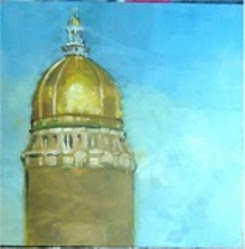If we think about it, each of our lives is molded by the actions of others--sometimes, perhaps most of the time, people we've never met. Painters today owe considerable debt to the titans of the past. The reputations and actions of people like Caravaggio, Rembrandt, and of the myriad other masters of bygone days has made a difference to those who came after them, however indirectly. And each painter today has been influenced as an artist and as a human being by many many people.
What got me thinking about the whole thing is a set of 100 portraits on the website of a gifted painter named Nicolas Uribe. You can see his work at
http://www.uribearts.com/ . One of the great things on his site is a set of portraits of various people who have exerted an influence on Uribe's life and work. On the Gallery page, you have to scroll to the right with the menu ribbon until you see a listing of "100 Portraits." Those are the ones showing his influences. Anyway, the more I looked at Uribe's work, the more it seemed to me that doing such a series would be a great way to practice portraiture and it can also provide opportunities to try out new methods, new mediums, etc. Good practice, good learning opportunities.
So I've begun my own group of Influences portraits. This is one of the first, Mohandas Gandhi (known in Hindi as "Bapu" or Father), done using an old photo. I simply drew the image with very thin raw umber, using a number 6 synthetic filbert.

After that I picked what I hoped was a relatively innocuous and (I hoped) enhancing green background. Then I painted the dark masses of Gandhi's face with raw umber, used a high-value white/yellow ochre for the robe, and called it finished. This is 14x11 on panel, done alla prima.
I've nearly finished another of Frederik Remington, the famous illustrator from about a century ago. I used a grainy, badly cropped photo, blew it up, printed it, added a derby hat (only the brim showed in the photo). Then I gridded up the resultant photo/drawing composite and transferred it to panel. Then I used an underpainting technique called "grisaille," mixing warm grays using raw umber and lead white. After it dries thoroughly, I'll be glazing the skin tones and adding a few grace notes. So that one will have been done in a completely different way.
As time goes along, I'll post Remington and perhaps, as I think of it, more of these as they're done. By the way, this one is not for sale.
Also, gouache is still on my mind. I'm thinking seriously about a whole series of athletes and athletic action scenes in gouache...maybe. More on that later.
 Here is a figure study after an old illustration by Joseph Leyendecker. The original has a rather shabby-looking painter frying a sausage while holding his empty palette. I changed him to imply that the viewer is the subject of a painting (the old master is looking at his subject--us). This is 16x12 on panel. Great fun to do because of the wonderful example provided by Leyendecker.
Here is a figure study after an old illustration by Joseph Leyendecker. The original has a rather shabby-looking painter frying a sausage while holding his empty palette. I changed him to imply that the viewer is the subject of a painting (the old master is looking at his subject--us). This is 16x12 on panel. Great fun to do because of the wonderful example provided by Leyendecker.

























